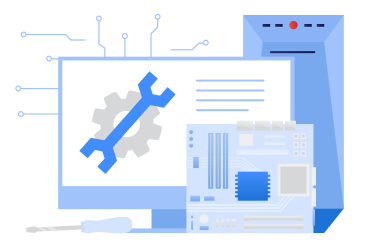In This Article

Embedded software is the hidden engine driving and powering everything related to IoT, from smart thermostats to cutting-edge medical devices. But what happens behind the scenes? The journey from a simple prototype to full-scale production is a complex and fascinating process that demands precision, specialized skills, and seamless collaboration.
By diving into this development cycle, we’ll uncover the complex layers of innovation that make today’s technology work. Let’s explore the brain behind the smart devices we rely on daily.
Key Considerations
Embedded software development presents unique challenges due to its interaction with hardware and real-time limits. Here are some key factors to consider:
- Real-time Constraints: Embedded systems must respond to events within strict time limits. Time-critical tasks, interrupt handling, and scheduling algorithms must be completed within specific deadlines.
- Hardware Constraints: Common challenges include limited memory, processing power, and power consumption. One must carefully manage memory while opting for a programming language based on the CPU’s capabilities.
- Safety and Reliability: Embedded software often controls critical systems, so the software has to be capable enough to handle errors and continue to operate without disastrous failures. Safety is also important, so one must adhere to industry standards and certifications.
- Security: Protecting against vulnerabilities, attacks, and security threats like malware and data breaches is important. To minimize vulnerabilities, one must follow secure coding guidelines and add encryption to protect sensitive data.
- Code Optimization: Coding must be optimized through profiling, identifying performance bottlenecks, optimizing algorithms, selecting the most efficient ones, and using appropriate data structures to optimize memory usage and access time.
1. Conceptualization and Design

The journey of embedded software development begins with the conceptualization and design phase. This early stage is where ideas are shaped into plans that serve as the foundation for the project.
Idea Generation and Requirement Assessment
The process starts with idea generation, where stakeholders brainstorm and outline the core objectives of the embedded systems solutions. This involves analyzing the issue at hand that requires a solution and visualizing how the software will interact with the hardware.
Subsequently, requirement assessment comes into play—a phase where developers collect and define the system’s functional and non-functional requirements. This includes performance criteria, user interface specifications, and limitations concerning power consumption and memory allocation.
A thorough requirement analysis ensures that all involved parties understand what goals the final product should accomplish.
Designing System Architecture
With requirements clarified, the thought process shifts to crafting the system architecture. The key is to create a plan that outlines the system’s components and interactions. The architecture needs to be strong and flexible enough to support updates and expansions.
For instance, when designing an embedded system for a home-based IoT device, architects must consider how the device will communicate with smart devices, optimize power usage, and deliver a smooth user experience. This phase also involves selecting the hardware and software platforms that meet the system’s requirements.
2. Building Prototypes and Developing

The project is now progressing toward building prototypes and development, which involves implementing theoretical designs through coding and integrating hardware.
Prototype Creation
Developing prototypes requires constructing a version of the embedded system to assess its feasibility and functionality. Developers write code, integrate it with chosen hardware, and perform tests to detect issues.
The prototype acts as a proof of concept, enabling developers to validate their design decisions and make modifications before embarking on full-scale development.
For example, a prototype for a fitness tracker might undergo testing for sensor precision, battery longevity, and user interface responsiveness.
Development of Software and Integration
The project proceeds to full-scale software development once a validated prototype is in place. During this phase, developers write code incorporating the system’s features and functionalities. Based on the system’s requirements, they utilize programming languages like C, C++, or Python.
Integration plays a significant role in this stage, ensuring the operation and compatibility of the software and hardware. Developers conduct integration testing to confirm that all elements interact properly and meet expectations.
Additionally, they work on developing firmware, which is the software that directly interacts with the hardware.
3. Testing and Validation

Extensive testing occurs during the testing and validation to ensure the system meets all defined requirements and operates under conditions.
Unit Testing and Debugging
Unit testing involves checking components or modules of the software to verify their functioning in isolation. Developers create test cases for each module to identify any errors or bugs. Debugging is a part of this stage, where developers address issues that surface during testing.
System Testing and Quality Assurance
System testing assesses how well all components of an embedded system work together seamlessly. This phase includes performance and stress testing to evaluate the system’s behavior in various scenarios.
Quality Assurance (QA) plays a role in this phase, ensuring the system complies with industry standards and regulations. For instance, medical devices must undergo testing to meet healthcare guidelines, confirming they are safe and effective for the targeted audience usage.
4. Deployment and Maintenance

The final step of the embedded software development process is deployment and maintenance. This is when the product is launched into the market, maintained, and updated throughout its life cycle.
Deployment
Deploying involves installing the software onto the hardware and preparing the system for production. This includes finalizing the firmware, optimizing software performance, and conducting acceptance tests to ensure the system is ready for use.
Continuous Maintenance and Updates
After deployment, the system goes into a maintenance phase, during which developers monitor its performance, address any bugs or issues, and release updates as necessary. This phase ensures the system remains functional and secure throughout its life cycle.
For instance, a smart thermostat might receive firmware updates to enhance security, introduce features, or boost performance. Continuous maintenance is essential to keeping up with advancements and meeting user needs.
Concluding Thoughts
Creating embedded software, from design to product release, is complex and ever-changing. It demands preparation, teamwork, and knowledge. Every stage, including conceptualization, design implementation, deployment, and maintenance, contributes significantly to the end product’s success.
As technology advances, the significance of embedded software development methodologies will continue to rise. These methodologies promote creativity and improve the capabilities of devices in the IoT and beyond.










